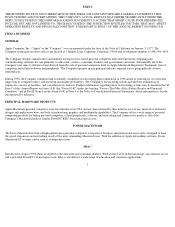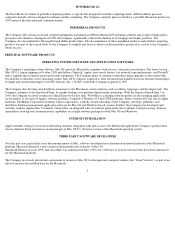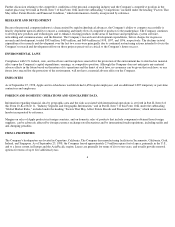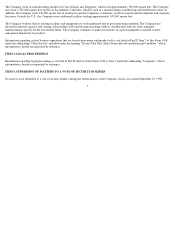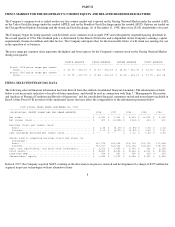Apple 1998 Annual Report Download - page 5
Download and view the complete annual report
Please find page 5 of the 1998 Apple annual report below. You can navigate through the pages in the report by either clicking on the pages listed below, or by using the keyword search tool below to find specific information within the annual report.platform. In fiscal 1997, the Company determined that the benefits of licensing the Mac OS to the Clone Vendors under these agreements were
more than offset by the impact and costs of the licensing program. As a result, the Company acquired certain assets, including the license to
distribute the Mac OS, of Power Computing Corporation ("PCC"), a Clone Vendor, and does not plan to extend or reinstate its other Mac OS
licensing agreements.
Further information regarding the Company's products may be found in Part II, Item 7 of this Form 10-K under the subheading "Competition"
included under the heading "Factors That May Affect Future Results and Financial Condition," which information is hereby incorporated by
reference.
MARKETS AND DISTRIBUTION
The Company's customers are primarily in the education, creative, consumer, business and government markets. Certain customers are
attracted to Macintosh computers for a variety of reasons, including the reduced amount of training resulting from the Macintosh computer's
intuitive ease of use, industrial design features of the Company's hardware products, the ability of Macintosh computers to network and
communicate with other computer systems and environments, and the availability of a wide variety of certain user-friendly application
software.
Apple personal computers were first introduced to education customers in the late 1970s. In the U.S., the Company is one of the major
suppliers of personal computers for both elementary and secondary school customers, as well as for college and university customers. The
Company is also a supplier to institutions of higher education outside of the U.S.
The U.S. represents the Company's largest geographic marketplace. The U.S. is part of the Apple Americas organization which focuses on the
Company's sales, marketing, and support efforts in North and South America. Products sold in the western hemisphere are primarily
manufactured in the Company's facilities in California and Singapore and under contract by external manufacturing vendors.
Approximately 45% of the Company's net sales in fiscal 1998 came from its international operations. The Company's international sales and
services divisions consist of: Apple Americas; Apple Europe, Middle East and Africa ("Apple EMEA"); Apple Japan; and Apple Asia Pacific
(which does not include Japan). The marketing divisions focus on sales, marketing and distribution in their regions. Products sold by Apple
EMEA are manufactured primarily in the Company's facility in Cork, Ireland, and by external manufacturing vendors. Products sold by Apple
Japan and Apple Asia Pacific are manufactured primarily in the Company's facility in Singapore and by external manufacturing vendors.
The Company distributes its products through wholesalers, resellers, national and regional retailers, cataloguers, and directly to education
institutions for resale (collectively referred to as "resellers"). In November 1997, the Company began selling many of its products directly to
end users in the U.S. through the Company's on-line store. Throughout fiscal 1998, the Company revised its distribution channel model and
related policies. As a result, the Company has significantly reduced the number of its distributors, authorized resellers, and national retail
channel partners, particularly in the United States. The Company also revised its distribution channel policies by decreasing the price protection
and stock return privileges of its remaining distributors and resellers.
RAW MATERIALS
Although certain components essential to the Company's business are generally available from multiple sources, other key components
(including microprocessors and application-specific integrated circuits) are currently obtained by the Company from single or limited sources.
Any availability limitations, interruption in supplies, or price increases relative to these and other components could adversely affect the
Company's business and financial results. In addition, new products introduced by the Company often initially utilize custom components
obtained from only one source, until the Company has evaluated
3



